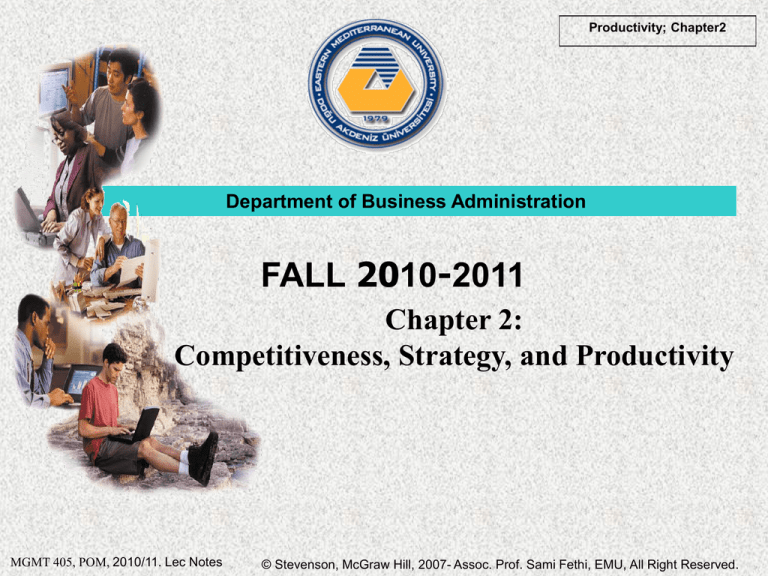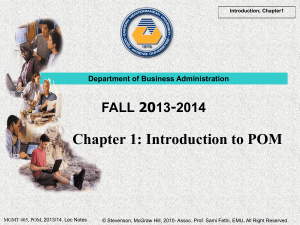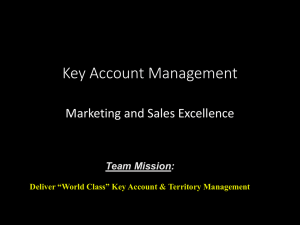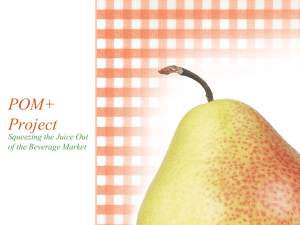
Productivity; Chapter2
Department of Business Administration
FALL 2010-2011
Chapter 2:
Competitiveness, Strategy, and Productivity
MGMT 405, POM, 2010/11. Lec Notes
© Stevenson, McGraw Hill, 2007- Assoc. Prof. Sami Fethi, EMU, All Right Reserved.
Outline: What You Will Learn . . .
Productivity; Chapter2
List and briefly discuss the primary ways that business
organizations compete.
List five reasons for the poor competitiveness of some
companies.
Define the term strategy and explain why strategy is important
for competitiveness.
Contrast strategy and tactics.
Discuss and compare organization strategy and operations
strategy, and explain why it is important to link the two.
Describe and give examples of time-based strategies.
Define the term productivity and explain why it is important to
organizations and to countries.
List some of the reasons for poor productivity and some ways of
improving it.
MGMT 405, POM, 2010/11. Lec Notes
2
© Stevenson, McGraw Hill, 2007- Assoc. Prof. Sami Fethi, EMU, All Right Reserved.
Competitiveness
Productivity; Chapter2
Competitiveness:
Companies must be competitive to sell their goods and
and services in the market
It is an important factor in determining whether a
company succeeds or fails
Marketing influences competitiveness in several ways
How effectively an organization meets the wants and needs of customers relative
to others that offer similar goods or services
3
MGMT 405, POM, 2010/11. Lec Notes
© Stevenson, McGraw Hill, 2007- Assoc. Prof. Sami Fethi, EMU, All Right Reserved.
Productivity; Chapter2
Competitiveness
Identifying consumer wants and needs
is a basic input organization’s decision making
process and central to competitiveness
Pricing
is a key factor in consumer buying decision
Advertising and promotion
is a key element that informs potential consumers
and attracts buyers
4
MGMT 405, POM, 2010/11. Lec Notes
© Stevenson, McGraw Hill, 2007- Assoc. Prof. Sami Fethi, EMU, All Right Reserved.
Productivity; Chapter2
Competitiveness-Important factors
Product and service design
Cost
Location
Quality
Quick response
Flexibility
Inventory management
Supply chain management
Service and service quality
Managers and workers
5
MGMT 405, POM, 2010/11. Lec Notes
© Stevenson, McGraw Hill, 2007- Assoc. Prof. Sami Fethi, EMU, All Right Reserved.
Productivity; Chapter2
Competitiveness -Important factors
product and service-special characteristics of product and
service design is a key factor in consumer buying decisions.
innovation and the time to market are also key factors for
new products and services.
cost of organization’s output is a key variable that
influences pricing decisions and profit policies.
location is an important factor in term of transportation
cost and convenience for customers.
quality is another key element that refers to materials,
workmanship, design and service.
quick response is a key factor that can be a competitive
advantage- quickly bring the new product or service into
market.
flexibility is the ability to respond to changes for the market
6
MGMT 405, POM, 2010/11. Lec Notes
© Stevenson, McGraw Hill, 2007- Assoc. Prof. Sami Fethi, EMU, All Right Reserved.
Productivity; Chapter2
Competitiveness -Important factors
Inventory management can be a competitive
advantage by effectively matching supplies of goods
with demand.
Supply chain management involves coordinating
internal and external operations to achieve timely
and cost-effectively delivery of goods throughout the
system.
service is a key differentiator- after sale activities
customers perceive as value-added such as delivery,
warranty work and technical support
managers and workers are the people at the heart
and soul of an organization (i.e. Skills and ideas).
7
MGMT 405, POM, 2010/11. Lec Notes
© Stevenson, McGraw Hill, 2007- Assoc. Prof. Sami Fethi, EMU, All Right Reserved.
Productivity; Chapter2
Why Some Organizations Fail?
Organizations fail or perform poorly for a variety of resons.
Being aware of such resons may help managers avoid making
similar mistake. Some of the reasons are following:
Too much emphasis on short-term financial performance at
the expense of research and development.
Failing to take advantage of strengths and opportunities
Failing to recognize competitive threats
Neglecting operations strategy
Failing to recognize competitive threats
Too much emphasis in product and service design and not
enough on improvement
Neglecting investments in capital and human resources
Failing to establish good internal communications
Failing to consider customer wants and needs
8
MGMT 405, POM, 2010/11. Lec Notes
© Stevenson, McGraw Hill, 2007- Assoc. Prof. Sami Fethi, EMU, All Right Reserved.
Two important questions?
Productivity; Chapter2
The key questions are following:
What do the customers want?
What is the best way to satify those wants?
Operations must work with marketing to
obtain information on the relative importance
of the various items to each major customer or
target market.
Understanding competitive issues can help
managers develop successful strategies.
9
MGMT 405, POM, 2010/11. Lec Notes
© Stevenson, McGraw Hill, 2007- Assoc. Prof. Sami Fethi, EMU, All Right Reserved.
Productivity; Chapter2
Strategy
Plans for achieving organizational goals
The importance of strategies should not be overstated
Strategies can be
Long-term
Intermediate-term
Short-term
Strategies can be effective if they are designed well to
support the organization’s mission and its goals:
10
MGMT 405, POM, 2010/11. Lec Notes
© Stevenson, McGraw Hill, 2007- Assoc. Prof. Sami Fethi, EMU, All Right Reserved.
Productivity; Chapter2
Mission and Goals
Mission
The reason for existence for an organization
Mission Statement
States the purpose of an organization
Goals
Provide detail and scope of mission
Strategies
Plans for achieving organizational goals
Tactics
The methods and actions taken to accomplish strategies
11
MGMT 405, POM, 2010/11. Lec Notes
© Stevenson, McGraw Hill, 2007- Assoc. Prof. Sami Fethi, EMU, All Right Reserved.
Productivity; Chapter2
Mission/Strategy/Tactics
Mission
Strategy
Tactics
How does mission, strategies and tactics relate to
decision making and distinctive competencies?
12
MGMT 405, POM, 2010/11. Lec Notes
© Stevenson, McGraw Hill, 2007- Assoc. Prof. Sami Fethi, EMU, All Right Reserved.
Productivity; Chapter2
Planning and Decision Making
Figure 2.1
The overall relationship from
Mission to Operation is hierarchical
Mission
Goals
Organizational Strategies
Functional Goals
Finance
Strategies
Tactics
Operating
procedures
Marketing
Strategies
Tactics
Operating
procedures
Operations
Strategies
Tactics
Operating
procedures
13
MGMT 405, POM, 2010/11. Lec Notes
© Stevenson, McGraw Hill, 2007- Assoc. Prof. Sami Fethi, EMU, All Right Reserved.
Productivity; Chapter2
Strategy Example
Rita is a high school student. She would like to
have a career in business, have a good job, and
earn enough income to live comfortably
Mission:
Goal:
Strategy:
Tactics:
Live a good life
Successful career, good income
Obtain a college education
Select a college and a major
how to finance college
Operations:
Register, buy books, take
courses, study, graduate, get job
14
MGMT 405, POM, 2010/11. Lec Notes
© Stevenson, McGraw Hill, 2007- Assoc. Prof. Sami Fethi, EMU, All Right Reserved.
Examples of Strategies
Productivity; Chapter2
Low cost: outsource operations to the third world
countries that have low labor costs.
Scale-based strategies: use the capital intensive
methods to achieve high output volume and low unit
cost.
Specialization: focus on norrow product lines or
limited services to achieve higher quality.
Flexible operations: focus on quick response.
High quality: focus on achieving higher quality
than competitors.
Service: focus on various aspects of service (e.g.,
helpful, courteous, reliable, etc.).
15
MGMT 405, POM, 2010/11. Lec Notes
© Stevenson, McGraw Hill, 2007- Assoc. Prof. Sami Fethi, EMU, All Right Reserved.
Productivity; Chapter2
Strategy and Tactics
Distinctive Competencies
The special attributes or abilities that give an
organization a competitive edge.
The most effective organizations use an approach that
develops distinctive competencies based on customer
needs and wants.
Strategy Factors
Price
Quality
Time
Flexibility
Service
Location
MGMT 405, POM, 2010/11. Lec Notes
16
© Stevenson, McGraw Hill, 2007- Assoc. Prof. Sami Fethi, EMU, All Right Reserved.
Productivity; Chapter2
Examples of Operations Strategies
Price
Low Cost
U.S. first-class postage
Motel-6, Red Roof Inns
Quality
High-performance design Sony TV
or high quality Consistent Lexus, Cadillac
quality
Pepsi, Kodak, Motorola
Time
Rapid delivery
On-time delivery
Express Mail, Fedex,
One-hour photo, UPS
Flexibility
Variety
Volume
Burger King
Supermarkets
Service
Superior customer
service
Disneyland
Nordstroms
Location
Convenience
Banks, ATMs
17
MGMT 405, POM, 2010/11. Lec Notes
© Stevenson, McGraw Hill, 2007- Assoc. Prof. Sami Fethi, EMU, All Right Reserved.
Productivity; Chapter2
Global Strategy
Many companies realized that strategic decisions
must be made with respect to globalization as it
has increased.
What works in one country may not work in
another
Strategies must be changed to account for these
differences
Other issues
Political, social, cultural, and economic
differences
18
MGMT 405, POM, 2010/11. Lec Notes
© Stevenson, McGraw Hill, 2007- Assoc. Prof. Sami Fethi, EMU, All Right Reserved.
Productivity; Chapter2
Key External Factors
Economic conditions: the general health, direction of the
economy, inflation, deflation, interest rates, tax laws and
tariffs.
Political conditions:favorable or unfavoable attitudes
toward business, political stability or instability and wars.
Legal environment:government regulations, trade
restriction, minimum wage law, labor law and patent.
Technology:product innovations and new design.
Competition: price, quality, special features and the ease of
market entry.
Markets: size, location, brand loyalties, potential for
growth, long-term stability, and demographics.
19
MGMT 405, POM, 2010/11. Lec Notes
© Stevenson, McGraw Hill, 2007- Assoc. Prof. Sami Fethi, EMU, All Right Reserved.
Productivity; Chapter2
Key Internal Factors
Human Resources: the skills and abilities of managers and
workers, special talent, loyalty, dedication and experience.
Facilities and equipment: capacities, location, age, cost and
replace.
Financial resources: funding, debt burden, cost of capital and
cash flow.
Customers: loyalty and understanding of wants and needs.
Products and services: quality, design and potential for new
products and services.
Technology:the ability to integrate new technology.
Suppliers: quality, flexibility, reliable and trustworthy in
service.
20
MGMT 405, POM, 2010/11. Lec Notes
© Stevenson, McGraw Hill, 2007- Assoc. Prof. Sami Fethi, EMU, All Right Reserved.
Productivity; Chapter2
Strategy Formulation
To formulate an effective strategy, senior managers must take
into account the followings:
Distinctive competencies
The special attributes or abilities that give an
organization a competitive edge.
Environmental scanning
The considering of events and trends that present threats
or opportunities for a company
SWOT-link between organizational and operations strategies
The is an approach shows strengths and weaknesses have an
internal focus and evaluated by operation people. The threats
and opportunities have external focus and evaluated by
marketing people.
21
MGMT 405, POM, 2010/11. Lec Notes
© Stevenson, McGraw Hill, 2007- Assoc. Prof. Sami Fethi, EMU, All Right Reserved.
Productivity; Chapter2
Strategy Formulation
Order qualifiers
Characteristics that customers perceive as
minimum standards of acceptability to be
considered as a potential purchase
Order winners
Characteristics of an organization’s goods
or services that cause it to be perceived as
better than the competition
22
MGMT 405, POM, 2010/11. Lec Notes
© Stevenson, McGraw Hill, 2007- Assoc. Prof. Sami Fethi, EMU, All Right Reserved.
Productivity; Chapter2
Operations Strategy
Operations strategy
The approach, consistent with organization strategy, that
is used to guide the operations function.
Quality-based strategies
Focuses on maintaining or improving the quality of an
organization’s products or services
Time-based strategies
Focuses on reduction of time needed to
accomplish tasks
23
MGMT 405, POM, 2010/11. Lec Notes
© Stevenson, McGraw Hill, 2007- Assoc. Prof. Sami Fethi, EMU, All Right Reserved.
Productivity; Chapter2
Time-based Strategies
JAN
FEB
MAR
APR
MAY
JUN
Planning
Designing
Processing
Changeover
On time!
Delivery
24
MGMT 405, POM, 2010/11. Lec Notes
© Stevenson, McGraw Hill, 2007- Assoc. Prof. Sami Fethi, EMU, All Right Reserved.
Productivity; Chapter2
Strategic OM Decisions
Decision Area
Affects
Product and service design
Costs, quality liability and environmental
Capacity
Cost structure, flexibility
Process selection and layout
Costs, flexibility, skill level, capacity
Work design
Quality of work life, employee safety, productivity
Location
Costs, visibility
Quality
Ability to meet or exceed customer expectations
Inventory
Costs, shortages
Maintenance
Costs, equipment reliability, productivity
Scheduling
Flexibility, efficiency
Supply chains
Costs, quality, agility, shortages, vendor relations
Projects
Costs, new products, services, or operating systems
25
MGMT 405, POM, 2010/11. Lec Notes
© Stevenson, McGraw Hill, 2007- Assoc. Prof. Sami Fethi, EMU, All Right Reserved.
Efficiency
Productivity; Chapter2
Economic Efficiency
It refers to the ratio of outputs to input. This means that
economic efficency is getting the most output from the
least amount of inputs.
Organizational Efficiency
It is a ratio of product or service outputs to land, capital or
labor inputs.
Efficiency (%) = (Output/Input)*100%
A coffee shop makes 150 coffees per hour. How efficent is
the operation as labor input produces 200 coffees per hour?
Efficiency (%) = (Output/Input)*100%
= (150/200)*100%
= 75%
26
MGMT 405, POM, 2010/11. Lec Notes
© Stevenson, McGraw Hill, 2007- Assoc. Prof. Sami Fethi, EMU, All Right Reserved.
Productivity; Chapter2
Productivity
Productivity
A measure of the effective use of resources, usually
expressed as the ratio of output to input
Productivity ratios are used for
Planning workforce requirements
Scheduling equipment
Financial analysis
Outputs
Productivity =
Partial measures
Inputs
output/(single input)
Multi-factor measures
output/(multiple inputs)
Total measure
output/(total inputs)
MGMT 405, POM, 2010/11. Lec Notes
27
© Stevenson, McGraw Hill, 2007- Assoc. Prof. Sami Fethi, EMU, All Right Reserved.
Productivity; Chapter2
Factors Affecting Productivity
Capital
Quality
Technology
Management
28
MGMT 405, POM, 2010/11. Lec Notes
© Stevenson, McGraw Hill, 2007- Assoc. Prof. Sami Fethi, EMU, All Right Reserved.
Productivity; Chapter2
Other Factors Affecting Productivity
Standardization
Quality
Use of Internet
Computer viruses
Searching for lost or misplaced items
Scrap rates
New workers
Safety
Shortage of IT workers
Layoffs
Labor turnover
Design of the workspace
Incentive plans that reward productivity
29
MGMT 405, POM, 2010/11. Lec Notes
© Stevenson, McGraw Hill, 2007- Assoc. Prof. Sami Fethi, EMU, All Right Reserved.
Productivity; Chapter2
Key Steps In Productivity
Develop productivity measures
Determine critical (bottleneck) operations
Develop methods for productivity
improvements
Establish reasonable goals
Get management support
Measure and publicize improvements
Don’t confuse productivity with efficiency
30
MGMT 405, POM, 2010/11. Lec Notes
© Stevenson, McGraw Hill, 2007- Assoc. Prof. Sami Fethi, EMU, All Right Reserved.
Productivity; Chapter2
Productivity Growth
Current Period Productivity – Previous Period Productivity
Previous Period Productivity
31
MGMT 405, POM, 2010/11. Lec Notes
© Stevenson, McGraw Hill, 2007- Assoc. Prof. Sami Fethi, EMU, All Right Reserved.
Productivity; Chapter2
Measures of Productivity
Partial
measures
Output Output
Output
Labor
Machine Capital
Multifactor
measures
Total
measure
Output
Labor + Machine
Output
Energy
Output
Labor + Capital + Energy
Goods or Services Produced
All inputs used to produce them
32
MGMT 405, POM, 2010/11. Lec Notes
© Stevenson, McGraw Hill, 2007- Assoc. Prof. Sami Fethi, EMU, All Right Reserved.
Productivity; Chapter2
Partial Productivity Measures
Labor
Productivity
Units of output per labor hour
Units of output per shift
Value-added per labor hour
Machine
Productivity
Units of output per machine hour
machine hour
Capital
Productivity
Units of output per dollar input
Dollar value of output per dollar input
Energy
Productivity
Units of output per kilowatt-hour
Dollar value of output per kilowatt-hour
33
MGMT 405, POM, 2010/11. Lec Notes
© Stevenson, McGraw Hill, 2007- Assoc. Prof. Sami Fethi, EMU, All Right Reserved.
Productivity; Chapter2
Example-Productivity
A company makes 7040 Units Produced and the
costs are reported as follows: Cost of labor of
$1,000, Cost of materials is $520 and Cost of
overhead is $2000.
What is the multifactor productivity?
MFP =
Output
Labor + Materials + Overhead
MFP =
(7040 units)
$1000 + $520 + $2000
MFP =2.0 units per dollar of input
34
MGMT 405, POM, 2010/11. Lec Notes
© Stevenson, McGraw Hill, 2007- Assoc. Prof. Sami Fethi, EMU, All Right Reserved.
Productivity; Chapter2
Example-Productivity Growht
If productivity increased from 80 to 84.
What is the productivity growth rate?
PGR =
PGR =
84-80
80
X 100
5%
35
MGMT 405, POM, 2010/11. Lec Notes
© Stevenson, McGraw Hill, 2007- Assoc. Prof. Sami Fethi, EMU, All Right Reserved.
Productivity; Chapter2
Example-Productivity
Determine the productivity for the following case.
(a) Four workers installed 720 sq yards of carpeting in eight
hours
(b) A machine produced 68 usable pieces in two hours
(a) Productivity= Yards of carpet installed
Labor hours worked
P=
720
4x8
P = 22.5 yards/ hours
36
MGMT 405, POM, 2010/11. Lec Notes
© Stevenson, McGraw Hill, 2007- Assoc. Prof. Sami Fethi, EMU, All Right Reserved.
Productivity; Chapter2
Example-Productivity
(b) Productivity= Useable pieces
Production time
P=
68
2
P = 34 pieces/ hours
37
MGMT 405, POM, 2010/11. Lec Notes
© Stevenson, McGraw Hill, 2007- Assoc. Prof. Sami Fethi, EMU, All Right Reserved.
Productivity; Chapter2
Example- Labor Productivity
A company that processes fruits and vegetables is able to
produce 400 cases of canned peaches in one-half hour with
four workers.
What is labor productivity
Labor Productivity = Quantity produced
Labor hours
LP =
400
4 x (1/2)
LP = 200 cases/ labor hours
38
MGMT 405, POM, 2010/11. Lec Notes
© Stevenson, McGraw Hill, 2007- Assoc. Prof. Sami Fethi, EMU, All Right Reserved.
Productivity; Chapter2
Thanks
39
MGMT 405, POM, 2010/11. Lec Notes
© Stevenson, McGraw Hill, 2007- Assoc. Prof. Sami Fethi, EMU, All Right Reserved.











